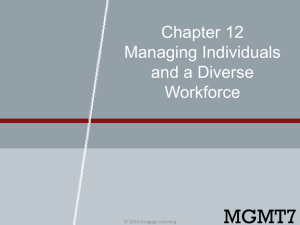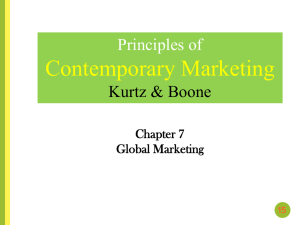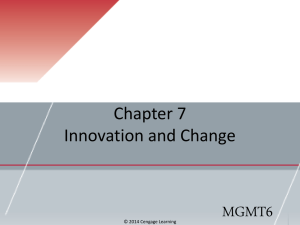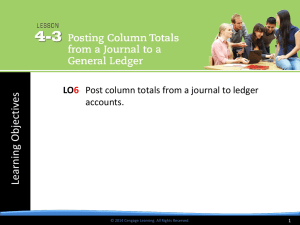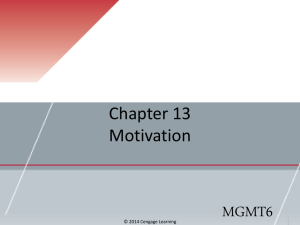Chapter 11 Textbook PowerPoint
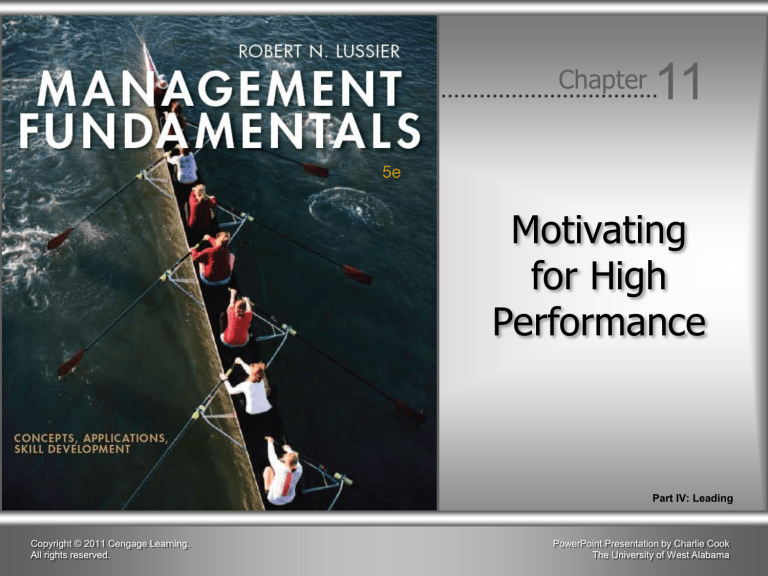
Copyright © 2011 Cengage Learning.
All rights reserved.
5e
Chapter 11
Motivating for High
Performance
Part IV: Leading
PowerPoint Presentation by Charlie Cook
The University of West Alabama
Learning Outcomes
After studying this chapter, you should be able to:
1.
Illustrate the motivation process.
2.
Explain the performance formula and how to use it.
3.
Discuss the major similarities and differences among the four content motivation theories: hierarchy of needs theory, ERG theory, two-factor theory, and acquired needs theory.
4.
Discuss the major similarities and differences among the three process motivation theories: equity theory, goal-setting theory, and expectancy theory.
5.
Explain the four types of reinforcement.
6.
State the major differences among content, process, and reinforcement theories.
7.
Define the key terms listed at the end of the chapter.
Copyright © 2011 Cengage Learning. All rights reserved.
11
–2
IDEAS ON MANAGEMENT
at Market America
1.
What does Market America do to motivate its distributors, and how does it affect performance?
2.
How does Market America meet its distributors’ content motivation needs?
3.
How does Market America meet its distributors’ process motivation needs?
4.
How does Market America use reinforcement theory to motivate its distributors?
5.
Does the Market America UnFranchise ® business model for motivation work in other countries?
Copyright © 2011 Cengage Learning. All rights reserved.
11
–3
Motivation and Performance
• Motivation
The willingness to achieve organizational objectives.
People are motivated by self-interest —the key to understanding motivation.
• Motivation Process
Employees go from need to motive to behavior to consequence to satisfaction or dissatisfaction.
Copyright © 2011 Cengage Learning. All rights reserved.
11
–4
How Motivation Affects Performance
• Expectations, Motivation, and Performance
Pygmalion effect
Managers’ attitudes toward, expectations of, and treatment of employees largely determine employees’ motivation and performance.
Self-fulfilling prophecy
“If you believe you can, or believe you can’t, then you are right”—Henry Ford.
If you think you will be successful, then you will be.
• The Performance Formula
Performance = Ability
×
Motivation
×
Resources
For maximum performance, all three factors must be high.
Copyright © 2011 Cengage Learning. All rights reserved.
11
–5
Copyright © 2011 Cengage Learning. All rights reserved.
11
–6
An Overview of Three Major Classes of Motivation Theories
Content Motivation
Theories
Process Motivation
Theories
Motivation
Copyright © 2011 Cengage Learning. All rights reserved.
Reinforcement
Theory
11
–7
Exhibit 11 –1 ●
Major Motivation Theories
Class of Motivation Theories Specific Theory (Creator)
Content motivation theories focus on identifying and understanding employees’ needs
Hierarchy of needs theory (Maslow) proposes that employees are motivated by five levels of needs: physiological, safety, social, esteem, and self-actualization.
ERG theory (Alderfer) proposes that employees are motivated by three needs: existence, relatedness, and growth.
Two-factor theory (Herzberg) proposes that employees are motivated by motivators (higher-level needs) rather than by maintenance factors (lower-level needs).
Acquired needs theory (McClelland) proposes that employees are motivated by their need for achievement, power, and affiliation.
Copyright © 2011 Cengage Learning. All rights reserved.
11
–8
Exhibit 11 –1 ● Major Motivation Theories (cont’d)
Class of Motivation Theories Specific Theory (Creator)
Process motivation theories focus on understanding how employees choose behaviors to fulfill the needs.
Equity theory (Adams) proposes that employees will be motivated when their perceived inputs equal outputs.
Goal-setting theory (Locke) proposes that achievable but difficult goals motivate employees.
Expectancy theory (Vroom) proposes that employees are motivated when they believe they can accomplish the task and the rewards for doing so are worth the effort.
Copyright © 2011 Cengage Learning. All rights reserved.
11
–9
Exhibit 11 –1 ● Major Motivation Theories (cont’d)
Class of Motivation Theories Specific Theory (Creator)
Reinforcement theory (Skinner) proposes that the consequences of behavior will motivate employees to behave in predetermined ways.
Types of reinforcement
Positive reinforcement is offering attractive consequences
(rewards) for desirable performance to encourage the continuation of that behavior.
Avoidance reinforcement is threatening to provide negative consequences for poor performance to encourage desirable behavior.
Punishment is providing an undesirable consequence
(punishment) for an undesirable behavior to prevent the behavior.
Extinction is the withholding of reinforcement for a particular behavior.
Copyright © 2011 Cengage Learning. All rights reserved.
11
–10
Maslow’s Hierarchy of Needs Theory
• Hierarchy of Needs
1.
2.
3.
4.
Only unmet needs motivate.
People’s needs are arranged in order of importance for basic to complex.
Satisfaction of lower-level needs precedes satisfaction of higher-level needs.
There are five levels of needs:
Physiological needs
Safety needs
Social needs
Esteem needs
Self-actualization needs
Copyright © 2011 Cengage Learning. All rights reserved.
11
–11
Exhibit 11 –2
How Managers Motivate
Based on Maslow‘s
Hierarchy of Needs Theory
Copyright © 2011 Cengage Learning. All rights reserved.
11
–12
ERG Theory
• ERG Theory (Alderfer)
Proposes that employees are motivated by three needs:
Existence: physiological and safety needs.
Relatedness: social needs.
Growth: esteem and self-actualization needs.
Needs can be active on more than one level at the same time.
Starving actor: being hungry and wanting fame and fortune.
Copyright © 2011 Cengage Learning. All rights reserved.
11
–13
Exhibit 11 –3 ● Herzberg’s Two-Factor Theory
Proposes that employees are motivated by motivators rather than by maintenance factors
Copyright © 2011 Cengage Learning. All rights reserved.
11
–14
Acquired Needs Theory
• Acquired Needs Theory (McClelland)
Proposes that employees are motivated by their needs for achievement, power, and affiliation.
Need for Achievement (n Ach): the desire for responsibility and accomplishment.
Need for Power (n Pow): the desire to control the situation, to influence others, to enjoy competition in which they can win, and to be willing to confront others.
Need for Affiliation (n Aff): the tendency to want to be liked, to seek close relationship with others, to enjoy social activities, and to seek to belong.
Copyright © 2011 Cengage Learning. All rights reserved.
11
–15
Exhibit 11 –4 ●
A Comparison of Four Content Motivation Theories
Copyright © 2011 Cengage Learning. All rights reserved.
11
–16
Motivation: Process Theories
• Process Motivation Theories
Focus on understanding how employees choose behavior to fulfill their needs.
Equity theory
Goal-setting theory
Expectancy theory
Copyright © 2011 Cengage Learning. All rights reserved.
11
–17
Equity Theory
• Equity Theory (Adams)
Proposes that employees are motivated when their perceived inputs equal outputs.
People compare their inputs (effort, experience, seniority, status, intelligence, etc.) and outputs
(praise, recognition, pay, benefits, promotions, increased status, supervisor’s approval, etc.) to those of relevant others and conclude that they are:
Underrewarded
Overrewarded
Equitably rewarded
Copyright © 2011 Cengage Learning. All rights reserved.
11
–18
Goal-Setting Theory
• Goal-Setting Theory
Proposes that goals that are challenging, achievable, specific, and measureable will motivate employees, leading them to higher levels of motivation and performance.
Copyright © 2011 Cengage Learning. All rights reserved.
11
–19
Join the Discussion
Ethics & Social Responsibility
• Academic Standards
1.
How many hours outside of class, on average, do you and other students you know spend preparing for class each week?
2.
Are college professors today assigning students 2 hours of preparation for every hour in class? If not, why do you think they have dropped this standard?
3.
Are students who are essentially doing part-time work (that is, attending classes but doing little or no academic work outside of class) during college being prepared for a career after graduation (with a 40- to 60-hour work weeks)?
4.
Is it ethical and socially responsible for professors to drop standards and for colleges to award degrees for doing less work than students did 5, 10, or 20 years ago?
Copyright © 2011 Cengage Learning. All rights reserved.
11
–20
Expectancy Theory
• Expectancy Theory (Vroom)
Proposes that employees are motivated when they believe they can accomplish a task and the rewards for doing so are worth the effort.
Motivation = Expectancy
×
Valence
Expectancy —the person’s perception of his or her ability to accomplish an objective.
Valence —the value the person places on the outcome or reward for his or her performance.
Instrumentality —the perception of the relationship between performance and reward.
Copyright © 2011 Cengage Learning. All rights reserved.
11
–21
Expectancy Theory (cont’d)
• Expectancy Theory Assumptions:
1.
2.
Both internal factors (needs) and external factors
(environment) affect behavior.
Behavior is the individual’s decision.
3.
People have different needs, desires, and goals.
4.
People make behavior decisions based on their perception of the outcome.
Copyright © 2011 Cengage Learning. All rights reserved.
11
–22
Expectancy Theory (cont’d)
• Keys to using expectancy theory successfully:
1.
Clearly define objectives and the performance needed to achieve them.
2.
Tie performance to rewards.
3.
Be sure rewards have value to employees.
4.
Make sure employees believe that management will do what it says it will.
Copyright © 2011 Cengage Learning. All rights reserved.
11
–23
Reinforcement Theory
• Reinforcement Theory
Proposes that through the consequences for behavior employees will be motivated to behave in predetermined ways.
Stimulus
Responding
Behavior
Consequences of Behavior
(Reinforcement)
Copyright © 2011 Cengage Learning. All rights reserved.
11
–24
Types of Reinforcement
• Positive Reinforcement
Encouraging continued behavior by offering attractive consequences (rewards) for desirable performance.
• Avoidance Reinforcement (Negative Reinforcement)
Encouraging continued desirable behavior to avoid a negative consequence.
• Punishment
Providing an undesirable consequence for the undesirable behavior.
• Extinction
Discouraging undesirable behavior by withholding reinforcement when the behavior occurs.
Copyright © 2011 Cengage Learning. All rights reserved.
11
–25
Exhibit 11 –5
Types of
Reinforcement
Copyright © 2011 Cengage Learning. All rights reserved.
11
–26
Schedules of Reinforcement
• Continuous Reinforcement
Each and every desirable behavior is reinforced.
• Intermittent Reinforcement
Time-based schedules
Fixed interval
Variable interval
Output-based schedules
Fixed ratio
Variable ratio
Copyright © 2011 Cengage Learning. All rights reserved.
11
–27
Motivating with Reinforcement
• General guidelines for using reinforcement:
1.
Make sure employees know what behavior is expected and reinforced.
2.
Select appropriate rewards.
3.
Select the appropriate reinforcement schedule.
4.
Do not reward mediocre or poor performance.
5.
Look for the positive and give praise regularly, rather than focusing on the negative and criticizing.
6.
Do things for your employees, instead of to them, and you will see productivity increases.
Copyright © 2011 Cengage Learning. All rights reserved.
11
–28
Join the Discussion
Ethics & Social Responsibility
• Airlines
1.
Not using an airline ticket fully breaks the airline’s rules, not any law, so it’s not illegal. But is it ethical and socially responsible of travelers to do so?
2.
Is it ethical and socially responsible of airlines to charge more for less travel?
3.
Is it ethical and socially responsible to punish people who break the ticket rules?
Copyright © 2011 Cengage Learning. All rights reserved.
11
–29
Copyright © 2011 Cengage Learning. All rights reserved.
11
–30
Join the Discussion
Ethics & Social Responsibility
• Using Reinforcement Theory
1.
Does reinforcement motivate you?
2.
Is reinforcement effective (does it serve to motivate) in today’s global economy?
3.
Is the use of reinforcement theory ethical and socially responsible or manipulative?
Copyright © 2011 Cengage Learning. All rights reserved.
11
–31
Exhibit 11 –6
●
The Motivation
Process and the
Motivation Theories
The groups of theories are complementary; each refers to a different stage in the motivation process or answers a different question.
Copyright © 2011 Cengage Learning. All rights reserved.
11
–32
Employee Rewards and Recognition
Reward Programs
Variable Pay Bonuses Profit Sharing Stock Options
Copyright © 2011 Cengage Learning. All rights reserved.
~
–33
Model 11 –1 ●
Giving Praise
Copyright © 2011 Cengage Learning. All rights reserved.
11
–34
Do Motivation Theories Apply Globally?
• Cultural Differences in Motivation
The source of motivation (intrinsic vs. extrinsic)
The level of needs on which people focus varies.
Individualistic societies tend to value individual accomplishment; collective societies tend to value group accomplishment and loyalty.
Copyright © 2011 Cengage Learning. All rights reserved.
11
–35
Copyright © 2011 Cengage Learning. All rights reserved.
11
–36
KEY TERMS
• acquired needs theory
• content motivation theories
• equity theory
• ERG theory
• expectancy theory
• giving praise model
• goal-setting theory
• hierarchy of needs theory
• motivation
• motivation process
• performance formula
• process motivation theories
• reinforcement theory
• two-factor theory
Copyright © 2011 Cengage Learning. All rights reserved.
11
–37


